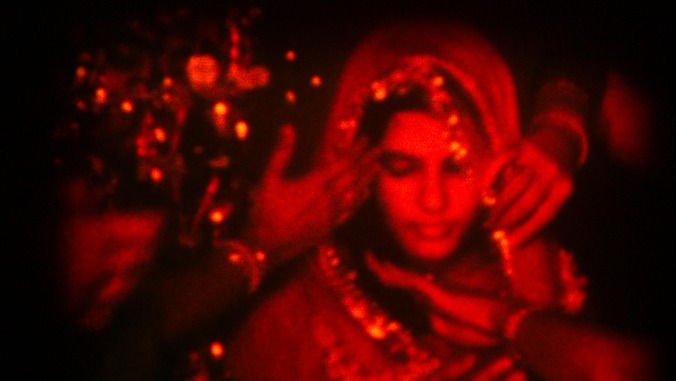A Night Of Knowing Nothing takes a sensuous look at student protests in India
The personal and political are juxtaposed in this promising debut from Payal Kapadia
Film Reviews A Night of Knowing Nothing
Payal Kapadia’s A Night Of Knowing Nothing opens in sensuous, somnolent darkness. A group of film students dance in front of an outdoor projection at nighttime, their bodies practically merging with the flickering screen. The scene initially plays out in silence, until we hear a hushed female voice reading a pair of intimate letters signed only “L.” We learn of how L.’s relationship with her boyfriend was cut short by his parents, who rejected her because she belongs to a lower caste. But in between the letters, we also hear raucous shouts and sounds of drumming, juxtaposing L.’s intensely personal story against a broadly political one: the waves of student protests that have swept India in recent years in response to the Modi government’s nationalist, anti-Muslim demagoguery. Such tensions—between sound and image, between the personal and the political—are characteristic of Kapadia’s film as a whole.
The immediate setting is the Film and Television Institute of India (FTII), where Kapadia herself studied. This is where L.’s letters are said to have been found, abandoned, in a box in an empty dorm room. And it is also where, in 2015, students protested against the appointment of Gajendra Chauhan, an actor and Bharatiya Janata Party member, as the school’s chairman. The FTII student strike was not simply a protest against Chauhan, with his ties to rightist, nationalist groups, but against the Modi government’s numerous politically motivated appointments to public institutions. However intense and harrowing their struggle proved, the FTII students’ movement was nationwide, with similar protests happening on campuses all across India.
Kapadia does not take a conventional documentary approach to these events. Her method is allusive and fragmentary, almost diaristic in its intimacy and evocation of personal feeling. Sound and image are rarely in sync, and A Night Of Knowing Nothing further incorporates a range of disparate images, textures, and materials. In addition to L.’s letters, we see doodle-like drawings, intensely colored photochemical film, and tranquil scenes of FTII students around campus (mostly captured in grainy black-and-white). We also see plenty of violent, disturbing material: CCTV footage of riot police storming a library filled with unarmed students; cellphone shots of masked men running rampant on school grounds; newspaper clippings that tell of horrific casteist and anti-Muslim violence. In one of her letters, L. writes about the difficulty of keeping up with the times, of making sense of the events transpiring all around her. Watching A Night Of Knowing Nothing, we too get the feeling that we’re stumbling in the dark.
Because of Kapadia’s collage-like approach, A Night Of Knowing Nothing occasionally feels loose and shapeless. But there is a discernible trajectory here. As the film goes on, it becomes increasingly likely that L.’s letters are a fictional device; there’s no definitive evidence that they are, but Kapadia doesn’t attempt to contextualize their discovery either. Still, their veracity matters less and less with every scene: As we watch any number of female students participate in the protests, the “truth” of L.’s situation no longer seems bound to a single, historical individual. Indeed, A Night Of Knowing Nothing eventually spirals out from L.’s personal heartbreak to raise larger questions of community and solidarity, particularly with respect to FTII as an institution. Student chants (“Eisenstein, Pudovkin, we will fight, we will win!”) point to the broader context and history of political cinema, while student meetings reflect on why a state-subsidized film school such as FTII should exist at all.
A Night Of Knowing Nothing offers no definitive answers to the questions it raises. But it’s not a coincidence that Kapadia continually foregrounds the importance of education, highlighting the students’ fight against absurd tuition hikes and systemic discrimination against Dalits on college campuses. One of the many protest signs we see reads “EDUCATE, AGITATE, ORGANISE,” and the order of these actions is crucial to the film, which sees education and freedom of thought as a primary—perhaps the primary—consideration of any social movement. In the final scene, a dance party brings things full circle, and we are reminded that a revolution involves more than just physical movement. Genuine change comes first with the freeing of the mind.